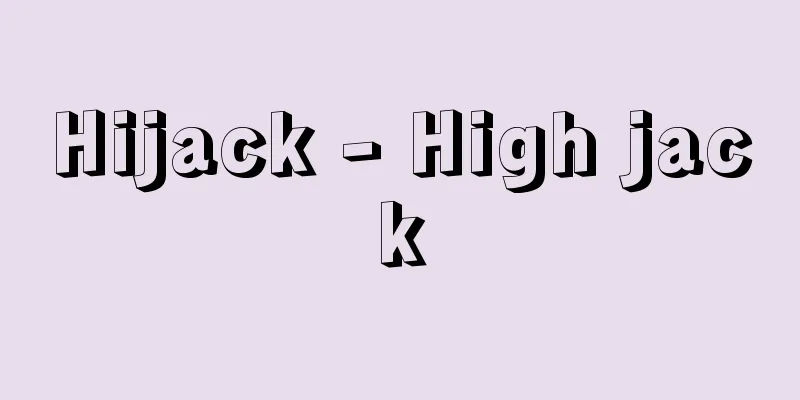Hijack - High jack

|
It is also called hijacking. It is the taking over of an aircraft, and in legal terms it is called aircraft hijacking or illegal seizure of an aircraft. Unlike pirates, the aim of hijacking is not to seize the aircraft itself, but to forcibly control the aircraft and control its operation. Hijackings have increased sharply since 1968, with 108 cases in 1972, and there were more than 100 cases in one year, which became a major threat to airlines, but due to prevention measures taken by various countries, the number has since decreased to about one case per month. There are several types of hijackings, such as defection types, political activity types (Arab guerrillas, Japanese Red Army, etc.), abnormal types (purposeless, impulsive, common in the United States), and recession types (more common since the global recession, ransom blackmail is the usual method). The first step in preventing hijacking is to prevent the criminals from boarding the aircraft, and other key points include strengthening police enforcement, preventing the bringing in of dangerous materials, and international cooperation. Measures such as guards and police patrols and boarding, locking of the cockpit, devices to detect metallic weapons, X-ray viewing televisions, body touching of passengers, and baggage inspections are being implemented, but the problem is that there is no definitive solution. Since the hijacking of a Japan Airlines plane by the Japanese Red Army in 1977, anti-hijacking measures have been strengthened, with restrictions on carry-on baggage and stricter security checks at airports, and at airports in dangerous overseas areas, a double check is being implemented with the cooperation of other countries, where a second check is carried out just before boarding. As for legal measures, it is essential to create a system in which the criminals are either handed over to the relevant country or given severe punishment in the country where they are located, so that hijacking does not pay. The 1963 Tokyo Convention (Convention on Offences and Certain Other Acts Committed on Board an Aircraft) only stipulated matters such as the flight after hijacking and the return of the aircraft and cargo, which was insufficient to prevent hijacking, so in 1970 the Hague Convention against the Unlawful Seizure of Aircraft was concluded. This treaty made hijacking a crime, mandated severe punishment, broadly recognized the jurisdiction of the relevant countries, and created a system in which criminals could not escape and would be subject to severe punishment no matter where they fled. The following year, 1971, the Montreal Convention (Convention for the Suppression of Unlawful Acts against the Safety of Civil Aviation) was signed to prevent acts of sabotage of aviation, such as carrying time bombs on board aircraft, destroying aircraft, and attacking airports. Following the hijacking of the Yodo-go plane in 1970, Japan enacted the Law Concerning the Punishment of Hijacking of Aircraft (commonly known as the Hijacking Punishment Law) and the Implementation Law for Article 13 of the Tokyo Convention, and subsequently acceded to the Tokyo Convention, after which it ratified the Hague Convention, and in 1974 enacted the Law Concerning the Punishment of Aviation Dangerous Acts (Law Concerning the Punishment of Acts That Endanger Aviation) and ratified the Montreal Convention. Then, in 1977, a Prevention Headquarters was established to strengthen anti-hijacking measures, and relevant laws were revised, imposing life imprisonment or a minimum of 10 years in prison for hijackers who take hostages and coerce them, heavy penalties for carrying explosives on board aircraft, and stricter restrictions on the issuance of passports. [Ikeda Fumio] Major hijackings of Japanese aircraftThe Japan Airlines Flight Yodo-go incident on March 31, 1970 (hijacked over Nagoya, nine Japanese Red Army members disembarked in Pyongyang), the All Nippon Airways Flight 175 incident on August 19 of the same year (hijacked over Nagoya, landed at Hamamatsu Airport, culprits arrested), the Japan Airlines Flight 351 incident on November 6, 1972 (hijacked over Nagoya, culprits arrested at Haneda), the Japan Airlines Flight 404 northbound incident on July 20, 1973 (hijacked after taking off from Amsterdam, flew to Dubai and was blown up at Benina Airport in Libya), the Japan Airlines Flight 124 incident on July 15, 1974 (hijacked over Hamamatsu, culprits arrested at Nagoya Airport), the Japan Airlines Flight 124 incident on July 15, 1975 (hijacked over Hamamatsu, culprits arrested at Nagoya Airport), the Japan Airlines Flight 124 incident on July 15, 1976 (hijacked over Hamamatsu, culprits arrested at Nagoya Airport), the Japan Airlines Flight 124 incident on July 15, 1977 (hijacked over Hamamatsu, culprits arrested at Nagoya Airport), the Japan Airlines Flight 124 incident on July 15, 1978 (hijacked over Hamamatsu, culprits arrested at Nagoya Airport), the Japan Airlines Flight 124 incident on July 15, 1979 ... The All Nippon Airways Flight 63 incident on July 28th (hijacked over Matsushima and the culprits arrested after landing at Haneda Airport), the Japan Airlines Flight 768 incident on January 5th 1976 (hijacked while docked in Manila, and the culprits arrested there), and the Japan Airlines Flight 472 incident on September 28th 1977 (the Dhaka incident. A Japan Airlines DC8 flight bound for Europe was hijacked after taking off from Bombay (now Mumbai) by five members of the Japanese Red Army and forced to land in Dhaka, the Japanese government complied with the culprits' demands, paid $6 million in ransom and released the six detainees, the plane took off from Dhaka on October 3rd and landed in Algiers, and the culprits released the last hostage after disembarking). [Ikeda Fumio] [Reference] |Source: Shogakukan Encyclopedia Nipponica About Encyclopedia Nipponica Information | Legend |
|
ハイジャッキングともいう。航空機乗っ取りのことで、法律用語では航空機強取(こうくうきごうしゅ)、航空機不法奪取という。海賊のように航空機自体の強奪を目的とせず、航空機を強制的にコントロールし、その運航を支配するのが特色である。ハイジャックは1968年より急増、72年108件と多い年は100件を超え、航空会社の大きな脅威となったが、各国の防止対策により、その後は、1か月にほぼ1件程度に減少した。ハイジャックには亡命型、政治活動型(アラブゲリラ、日本赤軍など)、異常型(無目的、衝動的なものでアメリカに多い)、不況型(世界が不況になって以来多く、身代金恐喝が常套(じょうとう)手段)などのいくつかのタイプがある。ハイジャック防止には犯人を乗り込ませないのが第一で、警察の取締り体制の強化、危険物の持ち込み防止、国際協力などの眼目がある。ガードマンや警官のパトロールと搭乗、航空機内の操縦室の施錠、金属性の武器を探知する装置、X線透視テレビ、乗客のボディー・タッチ、手荷物検査などが実施されているが、決定的な決め手がないのが悩みである。1977年(昭和52)の日本赤軍による日航機乗っ取り事件を契機として、ハイジャック防止対策が強化され、持ち込み手荷物を制限し、空港での安全チェックを厳重にし、海外危険地域の空港では、外国の協力を得て、搭乗直前に再度チェックするダブルチェックが実施されている。 法律面の対策としては、犯人を関係国に引き渡すか、所在国で厳罰に処し、ハイジャックは引き合わないという体制をつくることが肝要である。1963年の東京条約(航空機内で行なわれた犯罪その他ある種の行為に関する条約)は、ハイジャック後の飛行とか機体・貨物の返還などを取り決めただけで、ハイジャック防止には不十分なので、70年にハーグでハイジャック防止条約(航空機の不法な奪取の防止に関する条約)が結ばれた。この条約は、ハイジャックを犯罪とし、重罰を義務づけ、広く関係国の裁判権を認め、犯人がどこへ逃げても逃げきれず重刑に処される体制をつくった。翌71年には時限爆弾などの機内持ち込み、航空機破壊や空港攻撃などの航空不法妨害行為(サボタージュ)防止のモントリオール条約(民間航空の安全に対する不法な行為の防止に関する条約)が署名された。日本は1970年の「よど号」乗っ取り事件を契機として、「航空機の強取等の処罰に関する法律」(通称ハイジャック処罰法)、東京条約第13条の実施法などを制定して東京条約に加入したのち、ハーグ条約を批准し、74年には航空危険行為等処罰法(航空の危険を生じさせる行為等の処罰に関する法律)を制定してモントリオール条約を批准した。ついで1977年ハイジャック防止対策を強化するために防止対策本部を設置し、関係法令を改正、ハイジャック犯人が人質をとり強要した場合、無期または10年以上の懲役とし、爆発物の機内持ち込みに重刑を課し、旅券の発給を厳重にすることとした。 [池田文雄] 日本の航空機で生じたおもなハイジャック1970年3月31日の日航機「よど号」事件(名古屋上空で奪取され、日本赤軍9人平壌で降機)、同年8月19日の全日空175便事件(名古屋上空で奪取され、浜松飛行場に着陸、犯人逮捕)、72年11月6日の日航351便事件(名古屋上空で奪取され、羽田で犯人逮捕)、73年7月20日の日航北回り404便事件(アムステルダム離陸後奪取され、ドバイ空路を経てリビア・ベニナ空港で機体爆破)、74年7月15日の日航124便事件(浜松上空で奪取され、名古屋空港で犯人逮捕)、75年7月28日の全日空63便事件(松島上空で奪取され、羽田空港に着陸後犯人逮捕)、76年1月5日の日航768便事件(マニラ寄港中奪取されたが犯人は同地で逮捕)、77年9月28日の日航472便事件(ダッカ事件。日航南回り欧州線DC8がボンベイ(現ムンバイ)を離陸後、日本赤軍5人に奪取され、ダッカに強行着陸、日本政府は犯人の要求に応じ身代金として600万ドルを支払い、6人の被拘禁者を釈放、同機は10月3日ダッカを離陸し、アルジェに着陸、犯人が降機後最後の人質を解放)。 [池田文雄] [参照項目] |出典 小学館 日本大百科全書(ニッポニカ)日本大百科全書(ニッポニカ)について 情報 | 凡例 |
<<: Vaishali (English spelling)
>>: Vaishya - Baishya (English spelling)
Recommend
Kameshvara [I] - Kameshvara
...King Airlangga went into seclusion again four ...
Reverse transcription
… In the case of RNA viruses, which have RNA as t...
Ceremonial clothing - ceremonial clothing
…Combat uniforms are functional and practical, an...
Adventitious bud
A general term for buds that, for some reason, gro...
Artemisia monogyna
...The name santonin is said to have originated f...
Order to prosecute - Kisomeirei
When an order for provisional attachment or provis...
haustra coli (English spelling)
…the large intestine is contracted vertically by ...
Bow - Yumi
A type of weapon that uses the elasticity of a st...
New Year's calligraphy - Kakizome
It is also called "Kisho" or "Hats...
Challenging student - Ayanosho
...The origin of this group was a group of crafts...
Riyādh (English spelling)
The capital and largest city of Saudi Arabia. Loca...
Far East Nationalities Championships
A conference of representatives of democratic orga...
Heathrow Airport
…It is located 55 km northwest of Montreal and wi...
Ductility
A type of plasticity, which refers to the ease wi...
garmon' (English spelling) garmon
...The balalaika is a new instrument that appeare...









